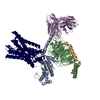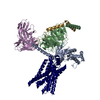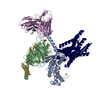登録情報 データベース : EMDB / ID : EMD-38528タイトル Cryo-EM structure of apo-GPR30-Gq complex structure 複合体 : GPR30-Gq complex複合体 : GPR30-Gqタンパク質・ペプチド : Guanine nucleotide-binding protein G(q) subunit alpha-qタンパク質・ペプチド : Guanine nucleotide-binding protein G(I)/G(S)/G(T) subunit beta-1タンパク質・ペプチド : Guanine nucleotide-binding protein G(I)/G(S)/G(O) subunit gamma-2タンパク質・ペプチド : G-protein coupled estrogen receptor 1複合体 : ScFv16リガンド : water / / / / / 機能・相同性 分子機能 ドメイン・相同性 構成要素
/ / / / / / / / / / / / / / / / / / / / / / / / / / / / / / / / / / / / / / / / / / / / / / / / / / / / / / / / / / / / / / / / / / / / / / / / / / / / / / / / / / / / / / / / / / / / / / / / / / / / / / / / / / / / / / / / / / / / / / / / / / / / / / / / / / / / / / / / / / / / / / / 生物種 Homo sapiens (ヒト) / synthetic construct (人工物) 手法 / / 解像度 : 2.9 Å Liu H / Xu P / Xu HE 資金援助 Organization Grant number 国 National Natural Science Foundation of China (NSFC)
ジャーナル : Cell Res / 年 : 2024タイトル : Structural and functional evidence that GPR30 is not a direct estrogen receptor.著者 : Heng Liu / Shimeng Guo / Antao Dai / Peiyu Xu / Xin Li / Sijie Huang / Xinheng He / Kai Wu / Xinyue Zhang / Dehua Yang / Xin Xie / H Eric Xu / 履歴 登録 2024年1月1日 - ヘッダ(付随情報) 公開 2024年4月10日 - マップ公開 2024年4月10日 - 更新 2024年7月10日 - 現状 2024年7月10日 処理サイト : PDBj / 状態 : 公開
すべて表示 表示を減らす
 データを開く
データを開く 基本情報
基本情報
 マップデータ
マップデータ 試料
試料 キーワード
キーワード 機能・相同性情報
機能・相同性情報 Homo sapiens (ヒト) / synthetic construct (人工物)
Homo sapiens (ヒト) / synthetic construct (人工物) データ登録者
データ登録者 中国, 1件
中国, 1件  引用
引用 ジャーナル: Cell Res / 年: 2024
ジャーナル: Cell Res / 年: 2024
 構造の表示
構造の表示 ダウンロードとリンク
ダウンロードとリンク emd_38528.map.gz
emd_38528.map.gz EMDBマップデータ形式
EMDBマップデータ形式 emd-38528-v30.xml
emd-38528-v30.xml emd-38528.xml
emd-38528.xml EMDBヘッダ
EMDBヘッダ emd_38528.png
emd_38528.png emd_38528_msk_1.map
emd_38528_msk_1.map マスクマップ
マスクマップ emd-38528.cif.gz
emd-38528.cif.gz emd_38528_half_map_1.map.gz
emd_38528_half_map_1.map.gz emd_38528_half_map_2.map.gz
emd_38528_half_map_2.map.gz http://ftp.pdbj.org/pub/emdb/structures/EMD-38528
http://ftp.pdbj.org/pub/emdb/structures/EMD-38528 ftp://ftp.pdbj.org/pub/emdb/structures/EMD-38528
ftp://ftp.pdbj.org/pub/emdb/structures/EMD-38528 emd_38528_validation.pdf.gz
emd_38528_validation.pdf.gz EMDB検証レポート
EMDB検証レポート emd_38528_full_validation.pdf.gz
emd_38528_full_validation.pdf.gz emd_38528_validation.xml.gz
emd_38528_validation.xml.gz emd_38528_validation.cif.gz
emd_38528_validation.cif.gz https://ftp.pdbj.org/pub/emdb/validation_reports/EMD-38528
https://ftp.pdbj.org/pub/emdb/validation_reports/EMD-38528 ftp://ftp.pdbj.org/pub/emdb/validation_reports/EMD-38528
ftp://ftp.pdbj.org/pub/emdb/validation_reports/EMD-38528 リンク
リンク EMDB (EBI/PDBe) /
EMDB (EBI/PDBe) /  EMDataResource
EMDataResource マップ
マップ ダウンロード / ファイル: emd_38528.map.gz / 形式: CCP4 / 大きさ: 64 MB / タイプ: IMAGE STORED AS FLOATING POINT NUMBER (4 BYTES)
ダウンロード / ファイル: emd_38528.map.gz / 形式: CCP4 / 大きさ: 64 MB / タイプ: IMAGE STORED AS FLOATING POINT NUMBER (4 BYTES) emd_38528_msk_1.map
emd_38528_msk_1.map 試料の構成要素
試料の構成要素 Homo sapiens (ヒト)
Homo sapiens (ヒト) Homo sapiens (ヒト)
Homo sapiens (ヒト)
 Homo sapiens (ヒト)
Homo sapiens (ヒト)

 Homo sapiens (ヒト)
Homo sapiens (ヒト)
 Homo sapiens (ヒト)
Homo sapiens (ヒト)

 解析
解析 試料調製
試料調製 電子顕微鏡法
電子顕微鏡法 FIELD EMISSION GUN
FIELD EMISSION GUN
 画像解析
画像解析 ムービー
ムービー コントローラー
コントローラー




































 Z
Z Y
Y X
X

























